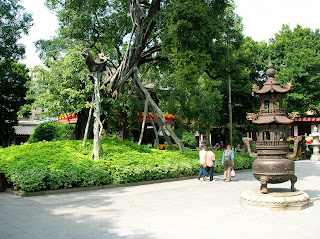Our last stop was Yuexiu Park. We took the subway here from Guangxiao Temple. It’s the largest park in downtown Guangzhou and was built in 1952. It’s made up of 3 artificial lakes as well as 7 hills of Yuexiu Mountain.
The Five-Ram Sculpture (though I’ve seen it called Five-Goats too) is the biggest attraction. You have to climb up a little hill/mountain to see it. It’s one of the most famous structures in Guangzhou. It has become the emblem of Guangzhou City. As you can also partly read in one of the pics below in Chinglish, legend has it that more than 2,000 years ago, Guangzhou was a barren land with people, who despite hard work, were suffering from famine. One day five immortals in five-color garments came riding on five rams, playing their legendary music. The rams held sheaves of rice in their mouths. The immortals left the sheaves of rice for the Guangzhou people, gave blessings to the city, and left. The rams turned into stone and the city of Guangzhou became a rich and populous place. Guangzhou got the name The City of Rams (or Ram City) and The City of Ears.
People exercise here as well as play music. Kids can go on rides and others can paint, sketch, fish or barbeque. There is a museum, tower, and an ancient City Wall here. There’s arched bridges, pavilions, corridors, trails, a swimming pool, gymnasium, restaurants, & souvenir stalls. There are also lots of grasses, trees, bamboos, birds, flowers, and animal life. Fittingly, there are five gates to enter the park and admission is free!
We stayed for a couple of hours before two of us decided to head back to Shenzhen. A couple people stayed another night in Guangzhou. A friend and I headed back to the subway to go to the train station to take the hour train ride back to Shenzhen. It was a long day and we saw a lot in one day (Qingping Market, Huangsha Market, Shamian Island, Guangxiao Temple, & Yuexiu Park). The park was great. I may have liked that the best. We decided to leave the park around 5pm and we would eat dinner once arriving in Shenzhen. We thought we would eat near Shenzhen’s train station because even after arriving at the train station in Shenzhen, it would still be another hour by subway and bus before we would actually get to our apartments. China is big! But of course, we were in China, and the train back to Shenzhen was late for some unknown reason. Actually, more than one was late. People were 50-deep anxiously waiting to get on the platform but they wouldn’t allow anyone to exit the station waiting area. Then, all of a sudden, the crowd started to push forward and we pushed with them. Of course, being in China again, our train # was nowhere to be found. We were trying to ask a lady that was working outside another train about our train (along with 20 others trying to ask this poor lady questions at the same time) and she didn’t know when our train would be available. The train she was working on was going to Shenzhen too and was supposed to leave after ours, so we were not sure where our train was or what was really going on. The lady said that we could get on this one but would have to stand. We were deciding what to do when a Chinese man in English told us to get on this train or we would be waiting for a long time. That was good enough for me. We left, standing…
We left the Guangzhou train station around 7:30 I would say and arrived an hour later. We found an Indian restaurant and had a nice dinner. After that, we left for home.
Guangzhou was nice. Not sure though I would go back unless I come across something new I want to see.














































